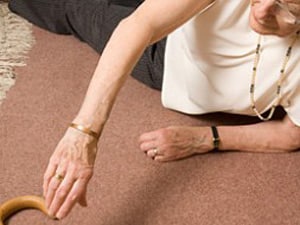 Background An observational study was conducted between April 20, 2007, and June 23, 2010, in two long-term care facilities in British Columbia, Canada. Digital video cameras were installed in common areas (dining rooms, lounges, hallways). When a fall occurred, facility staff completed an incident report and contacted our teams so that we could collect video footage. A team reviewed each fall video with a validated questionnaire that probed the cause of imbalance and activity at the time of falling. We then tested whether differences existed in the proportion of participants falling due to the various causes, and while engaging in various activities, with generalized linear models, repeated measures logistic regression, and log-linear Poisson regression. Findings The most common reason older individuals fall — at least among those living in long-term care facilities — is the incorrect shifting of body weight, researchers found. Of 227 falls captured on video, 41% were related to incorrect transfer or body weight shifting, Stephen Robinovitch, PhD, Simon Fraser University in Burnaby, British Columbia, and colleagues reported online in The Lancet. Other common causes included trips or stumbles (21%), hits or bumps (11%), loss of support with an external object (11%), and collapse or loss of consciousness (11%). The least common cause was slipping (3%). “By providing insight into the sequences of events that most commonly lead to falls, our results should lead to more valid and effective approaches for balance assessment and fall prevention in long-term care,” the authors wrote. Falls are the most frequent source of injury for individuals 65 and older, with a higher rate among those living in long-term care facilities. However, falls are not usually witnessed, and little objective evidence exists on the mechanism of falls. To help fill that gap, Robinovitch and colleagues conducted an observational study in two long-term care facilities in British Columbia, one with 312 beds and one with 236 beds. The facilities had existing networks of video surveillance cameras in all common areas, including dining rooms, lounges, and hallways. There were no cameras in bedrooms or bathrooms. For every fall, staff members completed an incident report and contacted the research team to collect the video footage. The researchers reviewed each video, using a structured questionnaire to collect data on the cause of the imbalance and the activity at the time of the fall. During a study period of more than 3 years, the researchers captured 227 falls by 130 individuals (mean age 78). About one in every five falls (21%) was associated with the use of mobility aids, including wheelchairs and walkers. That’s despite the fact that 74% of residents were classified as habitual users of the devices. The discrepancy illustrates “the high risk of transferring to and from, or neglecting to use, the device,” according to the researchers. Compared with previous studies looking at falls in older individuals, the current study showed a higher rate of falls during standing and transferring, a lower rate during walking, and a larger proportion resulting from center-of-mass disturbances rather than base-of-support disturbances like trips, stumbles, or slips. “These differences are probably partly attributable to the relatively higher prevalence of cognitive and physical impairment in the long-term care population we studied than in community-dwelling elderly people, with corresponding differences in fall mechanisms,” the researchers wrote. Aside from analyzing the causes of the falls, Robinovitch and colleagues identified the activities most commonly associated with falls. They included forward walking (24%), standing quietly (13%), and sitting down (13%). “Our findings emphasize the need to target each of these activities in fall risk assessment and prevention strategies,” the authors wrote. They acknowledged some limitations of the study, including the lack of analyses of the association between fall mechanisms and the medical status of the participants or between the amount of time spent doing various activities and falling, and the lack of a distinction between true syncope and collapse due to fatigue. In an accompanying editorial, Clemens Becker, MD, of Robert Bosch Hospital in Stuttgart, Germany, and Lorenzo Chiari, PhD, of the University of Bologna in Italy, noted that another major limitation was the lack of information on falls in private areas like bedrooms and bathrooms. “Other objective approaches are needed to study falls in these rooms, such as sensors worn on the body,” they wrote. An additional limitation was that the findings may not apply to seniors who live independently at home, they said. “To study falls in the community, we will need a technological shift. Evidence provided by Robinovitch and colleagues of the movement patterns that lead to falls is helpful in guiding the design of sensor-based fall monitoring systems,” Becker and Chiari wrote. “The next step will require coordinated action and possibly an open-access database that would allow real-world fall data, obtained through different sensors, to be shared.” Interpretation By providing insight into the sequences of events that most commonly lead to falls, our results should lead to more valid and effective approaches for balance assessment and fall prevention in long-term care. References: 1. Todd Neale, MedPage Today, Weight Transfer Tops Reasons Seniors Fall, October 16, 2012 2. Robinovitch S, et al “Video capture of the circumstances of falls in elderly people residing in long-term care: an observational study” Lancet 2012;DOI: 10.1016/S01406736(12)61263-X. Category: Physical Medicine
Background An observational study was conducted between April 20, 2007, and June 23, 2010, in two long-term care facilities in British Columbia, Canada. Digital video cameras were installed in common areas (dining rooms, lounges, hallways). When a fall occurred, facility staff completed an incident report and contacted our teams so that we could collect video footage. A team reviewed each fall video with a validated questionnaire that probed the cause of imbalance and activity at the time of falling. We then tested whether differences existed in the proportion of participants falling due to the various causes, and while engaging in various activities, with generalized linear models, repeated measures logistic regression, and log-linear Poisson regression. Findings The most common reason older individuals fall — at least among those living in long-term care facilities — is the incorrect shifting of body weight, researchers found. Of 227 falls captured on video, 41% were related to incorrect transfer or body weight shifting, Stephen Robinovitch, PhD, Simon Fraser University in Burnaby, British Columbia, and colleagues reported online in The Lancet. Other common causes included trips or stumbles (21%), hits or bumps (11%), loss of support with an external object (11%), and collapse or loss of consciousness (11%). The least common cause was slipping (3%). “By providing insight into the sequences of events that most commonly lead to falls, our results should lead to more valid and effective approaches for balance assessment and fall prevention in long-term care,” the authors wrote. Falls are the most frequent source of injury for individuals 65 and older, with a higher rate among those living in long-term care facilities. However, falls are not usually witnessed, and little objective evidence exists on the mechanism of falls. To help fill that gap, Robinovitch and colleagues conducted an observational study in two long-term care facilities in British Columbia, one with 312 beds and one with 236 beds. The facilities had existing networks of video surveillance cameras in all common areas, including dining rooms, lounges, and hallways. There were no cameras in bedrooms or bathrooms. For every fall, staff members completed an incident report and contacted the research team to collect the video footage. The researchers reviewed each video, using a structured questionnaire to collect data on the cause of the imbalance and the activity at the time of the fall. During a study period of more than 3 years, the researchers captured 227 falls by 130 individuals (mean age 78). About one in every five falls (21%) was associated with the use of mobility aids, including wheelchairs and walkers. That’s despite the fact that 74% of residents were classified as habitual users of the devices. The discrepancy illustrates “the high risk of transferring to and from, or neglecting to use, the device,” according to the researchers. Compared with previous studies looking at falls in older individuals, the current study showed a higher rate of falls during standing and transferring, a lower rate during walking, and a larger proportion resulting from center-of-mass disturbances rather than base-of-support disturbances like trips, stumbles, or slips. “These differences are probably partly attributable to the relatively higher prevalence of cognitive and physical impairment in the long-term care population we studied than in community-dwelling elderly people, with corresponding differences in fall mechanisms,” the researchers wrote. Aside from analyzing the causes of the falls, Robinovitch and colleagues identified the activities most commonly associated with falls. They included forward walking (24%), standing quietly (13%), and sitting down (13%). “Our findings emphasize the need to target each of these activities in fall risk assessment and prevention strategies,” the authors wrote. They acknowledged some limitations of the study, including the lack of analyses of the association between fall mechanisms and the medical status of the participants or between the amount of time spent doing various activities and falling, and the lack of a distinction between true syncope and collapse due to fatigue. In an accompanying editorial, Clemens Becker, MD, of Robert Bosch Hospital in Stuttgart, Germany, and Lorenzo Chiari, PhD, of the University of Bologna in Italy, noted that another major limitation was the lack of information on falls in private areas like bedrooms and bathrooms. “Other objective approaches are needed to study falls in these rooms, such as sensors worn on the body,” they wrote. An additional limitation was that the findings may not apply to seniors who live independently at home, they said. “To study falls in the community, we will need a technological shift. Evidence provided by Robinovitch and colleagues of the movement patterns that lead to falls is helpful in guiding the design of sensor-based fall monitoring systems,” Becker and Chiari wrote. “The next step will require coordinated action and possibly an open-access database that would allow real-world fall data, obtained through different sensors, to be shared.” Interpretation By providing insight into the sequences of events that most commonly lead to falls, our results should lead to more valid and effective approaches for balance assessment and fall prevention in long-term care. References: 1. Todd Neale, MedPage Today, Weight Transfer Tops Reasons Seniors Fall, October 16, 2012 2. Robinovitch S, et al “Video capture of the circumstances of falls in elderly people residing in long-term care: an observational study” Lancet 2012;DOI: 10.1016/S01406736(12)61263-X. Category: Physical Medicine
